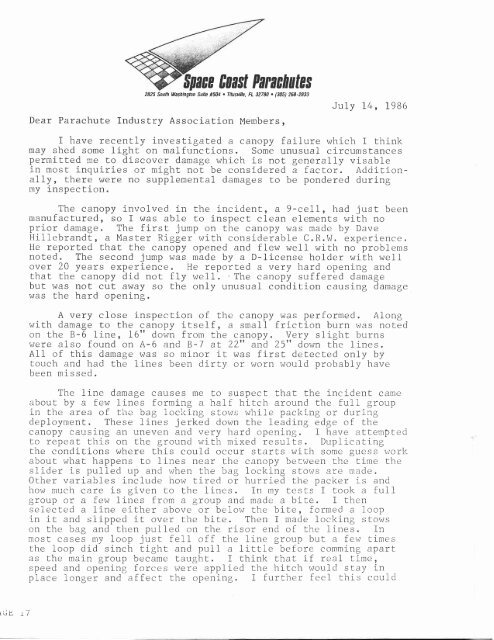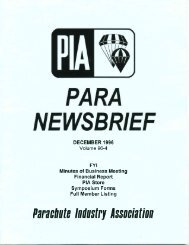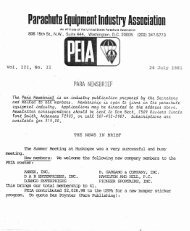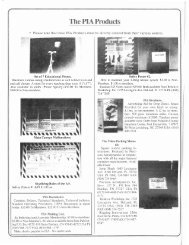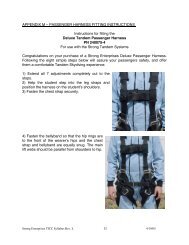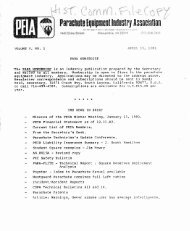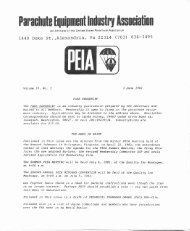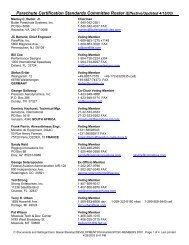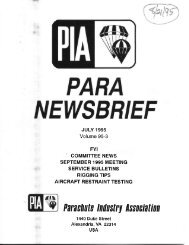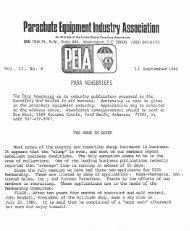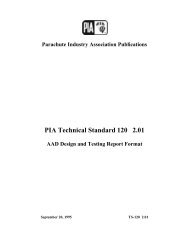Paracnuh hduslry l$s0clallon - Parachute Industry Association
Paracnuh hduslry l$s0clallon - Parachute Industry Association
Paracnuh hduslry l$s0clallon - Parachute Industry Association
Create successful ePaper yourself
Turn your PDF publications into a flip-book with our unique Google optimized e-Paper software.
'qne Eriast Parachtrltt;s<br />
2825 South Washington Suile 1504 . Titusviile, FL 32780 . (305) 268-2833<br />
Dear <strong>Parachute</strong> <strong>Industry</strong> <strong>Association</strong> Members,<br />
July L4, 1986<br />
I have recently investigated a canopy failure which I think<br />
may shed some light on malfunctions. Some unusual circumstances<br />
^^-*'i **^C<br />
PsItu! L LE\ me to discover damage which is not generally visable<br />
in most inquiries or might not be considered a factor. Additiona11y,<br />
there were no supplemental damages to be pondered during<br />
ny inspection.<br />
The canopy involved in the incident, a 9-ce11, had just been<br />
manufacturedr so I was able to inspect clean elements with no<br />
prior damage. The first ju*p on the canopy was made by Dave<br />
Hillebrandt, a Master Rigger with considerable C.R.W. experience.<br />
He reported that the canopy opened and flew well with no problems<br />
noted. The second jump was made by a D-license holder with well<br />
over 20 years experience. He reported a very hard opening and<br />
that the canopy bla not fly we11. , The "anopy<br />
sufferbd dailage<br />
but was not cut away so the only unusual condition causing damage<br />
was the hard opening.<br />
A very close inspection of the canopy was performed. Along<br />
with damage to the canopy itself, a sma11 friction burn was noted<br />
on the 8-6 line, 16" doi^rh f rom the canopy. Very slight burns<br />
v/ere also found on 4-6 and B-7 at 22" air-d 25" dbwn t6e lines.<br />
A11 of this damage was so minor it was first detected only by<br />
touch and had the lines been dirty or worn would probablv-have<br />
been missed.<br />
The line damaee causes me to susDect that the rncident came<br />
about by a few lines fornring a half fritch around the fu1l groLrp<br />
in the area of the bag locking stovrs wiril-e packing or during<br />
deployment. These lines jerked down the leading edge of the<br />
canopy causing an uneven and very hard opcning. I have attcmpted<br />
to repeat this on the ground with mixed results. Duplicating<br />
the conditions where this coulci occur starts lvith some guess r,.rork<br />
about what happens to lines near the canopy between the time the<br />
slider is pu11ed up and when the bag locking stows are nade.<br />
Other variables inclr-rde how tired or hurried the packer is and<br />
how much care is given to the lines. In my tests I took a ful1<br />
group or few lines from a group and made a bite. I then<br />
selecLed a line either above or belov,r the bite, f ormed a loop<br />
in it and slipped it over the bite. Then I made locking stows<br />
on the bag and then pulled on the risor end of the 1ines. In<br />
most cases my loop just fe11 off the line group but a few times<br />
the loop did sinch tight and pu11 a littie before comming apart<br />
as the main group became taught. I think that if real time,<br />
speed and opening forccs were applicd the hitch would stay in<br />
place longer and affect the opening. I further feel this could<br />
r.ir t'7


